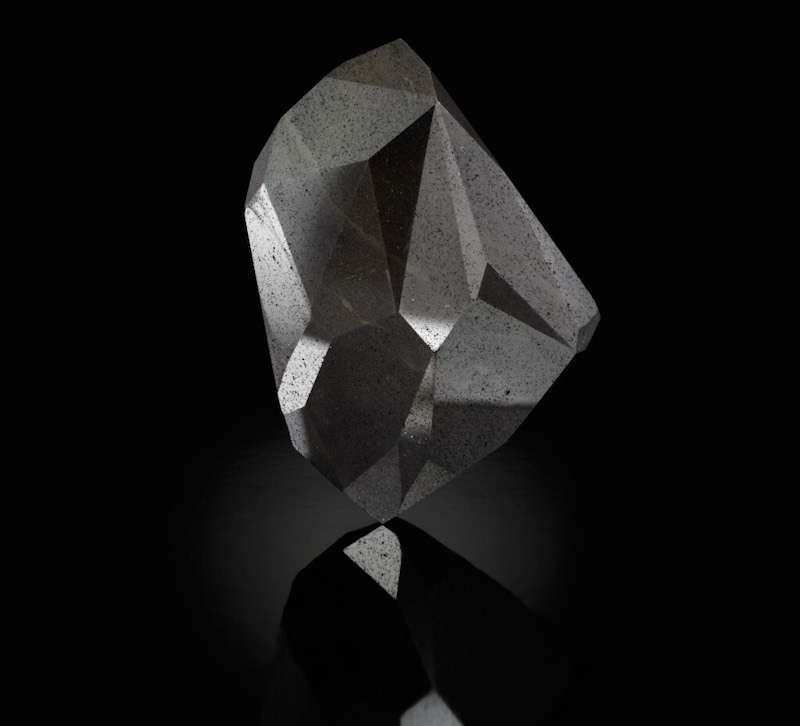Giant Bronze Mythical Beast Found at Famous Chinese Archeological Site-LOOK
The site at Sanxingdui, has yielded hundred of bronze statues which some archeologists say are more impressive than the Terracotta Army.

A giant black diamond with an origin unsolved for decades has sold at auction, despite scientists unsure whether it was formed from lava or dropped from a meteorite-or stranger things besides.
It's easy to be romantic about diamonds. As well as being 'forever' and 'a girl's best friend,' they also can harken back to the magic of human Mythology-such as the Hammer of Thor being forged in the heart of a dying star.
The extraordinary hardness of the stones, as well as the diversity of color, elicits theories about their formation that are equally incredible-and this jet black "carbonado" diamond weighing almost 4 ounces (111 grams), which is scientifically-unexplainable, is a perfect example.
Aptly named 'The Enigma Diamond', it fetched $4.3 million at Sotheby's, as the largest faceted diamond to ever appear on the auction market. Weighing a staggering 555.55 carats, the black naturally-colored diamond surpasses the weight of other giants like the 530-carat Great Star of Africa.
Cutting Enigma into its 55 facets took three years, due to the carbonado diamond's hardness.
Exactly what a carbonado diamond is, and how it is formed, scientists don't know-and their lack of certainty has led to some fascinating possibilities. They do know that Enigma, and all other carbonados, formed in an unknown event around 3-4 billion years ago-and they're only ever been found in Brazil and the Central African Republic.
As diamonds are formed hundreds of miles below the earth's surface, they often encapsulate other minerals. Carbonados contain unique collections of minerals, such as a titanium nitride called "osbornite", not found in any other diamonds but which is commonly found in meteorites.

Another curiosity of carbonados is their age. They are always at least 500 million years older than the oldest-ever diamond found in other sources like Kimberlites, which are essentially church-organ-like tubes that shot diamonds out in spurts of lava millions of years ago. Furthermore, the true host rock of carbonados, the magma-based minerals they were born of, has never been identified.
"A revised model for the origin of carbonado is developed based on: (1) new observations which show that white dwarf stars can have diamond cores; (2) carbon-rich exoplanets may have diamond-bearing mantles; and (3) new shock wave experiments on methane suggest that diamond may be present in large gaseous planets such as Saturn, Uranus, and Neptune where diamond in the core is solid, and in Jupiter where liquid diamond may be present," writes Stephen Haggerty, the pioneering geologist and diamond expert who in 1996 first proposed that carbonados come from meteorites.
However, any diamonds ever found in meteorites have been truly minuscule, while carbonados are regularly quite large. As the science of carbonados advanced, evidence that osbornite has been found in Earth's crust has lead other researchers to develop theories that the black diamonds are homegrown.
Diamonds are at their heart, a form of carbon. Yet carbonados, true to their mysterious nature, are formed from the light carbon isotope C12; in other words, the carbon that makes up biological life.
"Are carbonados fossils of the very earliest organisms to form on Earth?" Peter Heaney a mineralogist at Pennsylvania State University, pondered in Nat Geo. "Nobody knows the answer to that."
This idea has been proposed before as an explanation for other common diamonds, but another possibility is that the strange black diamonds, like common ones, were formed in the mantle. This was previously thought impossible. However, in 2010, another carbonado researcher found strikingly similar diamonds in a truly ancient form of crystalized lava called komatiite, which flowed like a liquid, during Earth's early history to around 2.7 billion years ago.
The komatiite theory contains a model in which carbonado-like diamonds could be formed in these unthinkably hot lava flows, but doesn't explain yet another curious feature of The Enigma diamond and other carbonados.
The surfaces of these black diamonds are covered in pores, a feature which under the extreme heat and pressure near the Earth's core would simply not allow a crystal to remain intact. Heaney thinks the pores contained radioactive phosphate minerals which left the pores as they decayed, and darkened the diamonds' color in the same process.
Haggerty proposes another extraterrestrial theory for the pores, which is that they were formed as molten carbon degassed on the surface of a dying star.
Whatever the secret behind the formation of these strange black diamonds, there is no doubt that they are extremely captivating in all respects. And whether they came from an erupting lake of liquid diamond on a far away world, and then carried here on a meteorite, or whether they were forged in Mount Doom by Tolkien's Sauron, there's no origin story that isn't sufficiently mind-blowing to be featured in a fantasy book.
SHINE On This Crazy Diamond and Share With Friends on Social Media…
Editors note: This story has been altered to correct a previous editor's misunderstandings of the difference between The Hobbit and the mythology of Thor.
Be the first to comment